The Change of Electronic Transport Behaviors by P and B Doping in Nano-Crystalline Silicon Films with Very High Conductivities
Abstract
:1. Introduction
2. Materials and Methods
3. Results and Discussion
3.1. Nanostructure
3.2. Temperature-Dependent Conductivity
3.3. Temperature-Dependent Hall Mobility
4. Conclusions
Acknowledgments
Author Contributions
Conflicts of Interest
References
- Prido, F.; Gregorkiewicz, T.; Galli, M.; Krauss, T.F. Silicon nanostructures for photonics and photovoltaics. Nat. Nanotechnol. 2014, 9, 19–32. [Google Scholar]
- Mu, W.W.; Zhang, P.; Xu, J.; Sun, S.H.; Xu, J.; Li, W.; Chen, K.J. Direct-Current and Alternating-Current Driving Si Quantum Dots-Based Light Emitting Device. IEEE J. Sel. Top. Quant. 2014, 20, 8200106. [Google Scholar]
- Flaig, F.M.; Rinck, J.; Stephan, M.; Bocksrocker, T.; Bruns, M.; Kübel, C.; Powell, A.K.; Ozin, G.A.; Lemmer, U. Multicolor Silicon Light-Emitting Diodes (SiLEDs). Nano Lett. 2013, 13, 475–480. [Google Scholar] [CrossRef] [PubMed]
- Cao, Y.Q.; Lu, P.; Zhang, X.; Xu, J.; Xu, L.; Chen, K.J. Enhanced photovoltaic property by forming p-i-n structures containing Si quantum dots/SiC multilayers. Nanoscale Res. Lett. 2014, 9, 634. [Google Scholar] [CrossRef] [PubMed]
- Lien, Y.C.; Shieh, J.M.; Huang, W.H.; Tu, C.H.; Wang, C.; Shen, C.H.; Dai, B.T.; Pan, C.L.; Hu, C.M.; Yang, F.L. Fast programming metal-gate Si quantum dot nonvolatile memory using green nanosecond laser spike annealing. Appl. Phys. Lett. 2012, 100, 143501. [Google Scholar] [CrossRef]
- Xu, J.; Zhang, P.Z.; Li, W.; Xu, J.; Chen, K.J. Nanoscale quantification of charge injection and transportation process in Si-nanocrystal based sandwiched structure. Nanoscale 2013, 5, 9971–9977. [Google Scholar] [CrossRef] [PubMed]
- Park, S.; Cho, E.C.; Song, D.Y.; Conibeer, G.; Green, M.A. n-Type silicon quantum dots and p-type crystalline silicon heteroface solar cells. Sol. Energy Mater. Sol. Cell 2009, 93, 684–690. [Google Scholar] [CrossRef]
- Cao, Y.Q.; Xu, J.; Ge, Z.Y.; Zhai, Y.Y.; Li, W.; Jiang, X.F.; Chen, K.J. Enhanced broadband spectral response and energy conversion efficiency for hetero-junction solar cells with graded-sized Si quantum dots/SiC multilayers. J. Mater. Chem. C 2015, 3, 12061–12067. [Google Scholar] [CrossRef]
- Rui, Y.J.; Li, S.X.; Xu, J.; Song, C.; Jiang, X.F.; Li, W.; Chen, K.J.; Wang, Q.M.; Zuo, Y.H. Size-dependent electroluminescence from Si quantum dots embedded in amorphous SiC matrix. J. Appl. Phys. 2011, 110, 064332. [Google Scholar] [CrossRef]
- Hong, S.H.; Kim, Y.S.; Lee, W.; Kim, Y.H.; Song, J.Y.; Jang, J.S.; Park, J.H.; Choi, S.H.; Kim, K.J. Active doping of B in silicon nanostructures and development of a Si quantum dot solar cell. Nanotechnology 2011, 22, 425203. [Google Scholar] [CrossRef] [PubMed]
- Ni, Z.Y.; Pi, X.D.; Yang, D.R. Doping Si nanocrystals embedded in SiO2 with P in the framework of density functional theory. Phys. Rev. B 2014, 89, 035312. [Google Scholar] [CrossRef]
- Hong, S.H.; Park, J.H.; Shin, D.H.; Kim, C.O.; Choi, S.H.; Kim, K.J. Doping- and size-dependent photovoltaic properties of p-type Si-quantum-dot heterojunction solar cells: Correlation with photoluminescence. Appl. Phys. Lett. 2010, 97, 072108. [Google Scholar] [CrossRef]
- Dalpian, G.M.; Chelikowsky, J.R. Self-Purification in Semiconductor Nanocrystals. Phys. Rev. Lett. 2006, 96, 226802. [Google Scholar] [CrossRef] [PubMed]
- König, D.; Gutsch, S.; Gnaser, H.; Wahl, M.; Kopnarski, M.; Göttlicher, J.; Steininger, R.; Zacharias, M.; Hiller, D. Location and Electronic Nature of Phosphorus in the Si Nanocrystal-SiO2 System. Sci. Rep. 2015, 5, 09702. [Google Scholar] [CrossRef] [PubMed]
- Fang, H.Y.; Luo, Z.Q.; Yang, H.R.; Wu, Y. The Effects of the Size and the Doping Concentration on the Power Factor of n-type Lead Telluride Nanocrystals for Thermoelectric Energy Conversion. Nano Lett. 2014, 14, 1153–1157. [Google Scholar] [CrossRef] [PubMed]
- Nakamura, T.; Adachi, S.; Fujii, M.; Sugimoto, H.; Miura, K.; Yamamoto, S. Size and dopant-concentration dependence of photoluminescence properties of ion-implanted phosphorus- and boron-codoped Si nanocrystals. Phys. Rev. B 2015, 91, 165424. [Google Scholar] [CrossRef]
- Das, D.; Sain, B. Electrical transport phenomena prevailing in undoped nc-Si/a-SiNx:H thin films prepared by inductively coupled plasma chemical vapor deposition. J. Appl. Phys. 2013, 114, 073708. [Google Scholar] [CrossRef]
- Song, C.; Xu, J.; Wang, Q.B.; Zha, G.W.; Li, W.; Chen, K.J. Carrier transport of doped nanocrystalline Si formed by annealing of amorphous Si films at various temperatures. Solid State Commun. 2011, 151, 697–700. [Google Scholar] [CrossRef]
- Song, C.; Xu, J.; Chen, G.R.; Sun, H.C.; Liu, Y.; Li, W.; Xu, L.; Ma, Z.Y.; Chen, K.J. High-conductive nanocrystalline silicon with phosphorous and boron doping. Appl. Surf. Sci. 2010, 257, 1337–1341. [Google Scholar] [CrossRef]
- Song, C.; Chen, G.R.; Xu, J.; Wang, T.; Sun, H.C. Evaluation of microstructures and carrier transport behaviors during the transition process from amorphous to nanocrystalline silicon thin films. J. Appl. Phys. 2009, 105, 054901. [Google Scholar] [CrossRef]
- Vautsas, A.T.; Hatalis, M.K.; Boyce, J.B.; Chiang, A. Raman spectroscopy of amorphous and microcrystalline silicon films deposited by low-pressure chemical vapor deposition. J. Appl. Phys. 1995, 78, 6999. [Google Scholar] [CrossRef]
- Song, C.; Wang, X.; Huang, R.; Song, J.; Guo, Y.Q. Effects of doping concentration on the microstructural and optoelectrical properties of boron doped amorphous and nanocrystalline silicon film. Mater. Chem. Phys. 2013, 142, 292–296. [Google Scholar] [CrossRef]
- Saleh, R.; Nickel, N.H. The influence of boron concentrations on structural properties in disorder silicon films. Appl. Surf. Sci. 2007, 254, 580–585. [Google Scholar] [CrossRef]
- Hao, X.J.; Cho, E.-C.; Flynn, C.; Shen, Y.S.; Conibeer, G.; Green, M.A. Effects of boron doping on the structural and optical properties of silicon nanocrystals in asilicon dioxide matrix. Nanotechnology 2008, 19, 424019. [Google Scholar] [CrossRef] [PubMed]
- Stegner, A.R.; Pereira, R.N.; Klein, K.; Lechner, R.; Dietmueller, R.; Brandt, M.S.; Stutzmann, M.; Wiggers, H. Electronic Transport in Phosphorus-Doped Silicon Nanocrystal Networks. Phys. Rev. Lett. 2008, 100, 026803. [Google Scholar] [CrossRef] [PubMed]
- Luo, P.Q.; Zhou, Z.B.; Chan, K.Y.; Tang, D.Y.; Cui, R.Q.; Dou, X.M. Gas doping ratio effects on p-type hydrogenated nanocrystalline silicon thin films grown by hot-wire chemical vapor deposition. Appl. Surf. Sci. 2008, 255, 2910–2915. [Google Scholar] [CrossRef]
- Ward, R.J.; Wood, B.J. A comparison of experimental and theoretically derived sensitivity factors for XPS. Surf. Interface Anal. 1992, 18, 679–684. [Google Scholar] [CrossRef]
- Myong, S.Y.; Lim, K.S.; Konagai, M. Effect of hydrogen dilution on carrier transport in hydrogenated boron-doped nanocrystalline silicon-silicon carbide alloys. Appl. Phys. Lett. 2006, 88, 103120. [Google Scholar] [CrossRef]
- Lechner, R.; Stegner, A.R.; Pereira, R.N.; Dietmueller, R.; Brandt, M.S.; Ebbers, A.; Trocha, M.; Wiggers, H.; Stutzmann, M. Electronic properties of doped silicon nanocrystal films. J. Appl. Phys. 2008, 104, 053701. [Google Scholar] [CrossRef]
- Juneja, S.; Sudhakar, S.; Gope, J.; Lodhi, K.; Sharma, M.; Kumar, S. Highly conductive boron doped micro/nanocrystalline silicon thin films deposited by VHF-PECVD for solar cell applications. J. Alloys Compd. 2015, 643, 94–99. [Google Scholar] [CrossRef]
- Guerra, R.; Ossicini, S. Preferential positioning of dopants and co-dopants in embedded and freestanding Si nanocrystals. J. Am. Chem. Soc. 2014, 136, 4404–4409. [Google Scholar] [CrossRef] [PubMed]
- Nussbaumer, H.; Baumgartner, F.P.; Willeke, G.; Bucher, E. Hall mobility minimum of temperature dependence in polycrystalline silicon. J. Appl. Phys. 1998, 83, 292. [Google Scholar] [CrossRef]
- Seto, J.Y.W. The electrical properties of polycrystalline silicon films. J. Appl. Phys. 1975, 46, 5247. [Google Scholar] [CrossRef]
- Scheller, L.-P.; Nickel, N.H. Charge transport in polycrystalline silicon thin-films on glass substrates. J. Appl. Phys. 2012, 112, 013713. [Google Scholar] [CrossRef]
- Lu, P.; Mu, W.W.; Xu, J.; Zhang, X.W.; Zhang, W.P.; Li, W.; Chen, K.J. Phosphorus Doping in Si Nanocrystals/SiO2 msultilayers and Light Emission with Wavelength compatible for Optical Telecommunication. Sci. Rep. 2016, 6, 22888. [Google Scholar] [CrossRef] [PubMed]
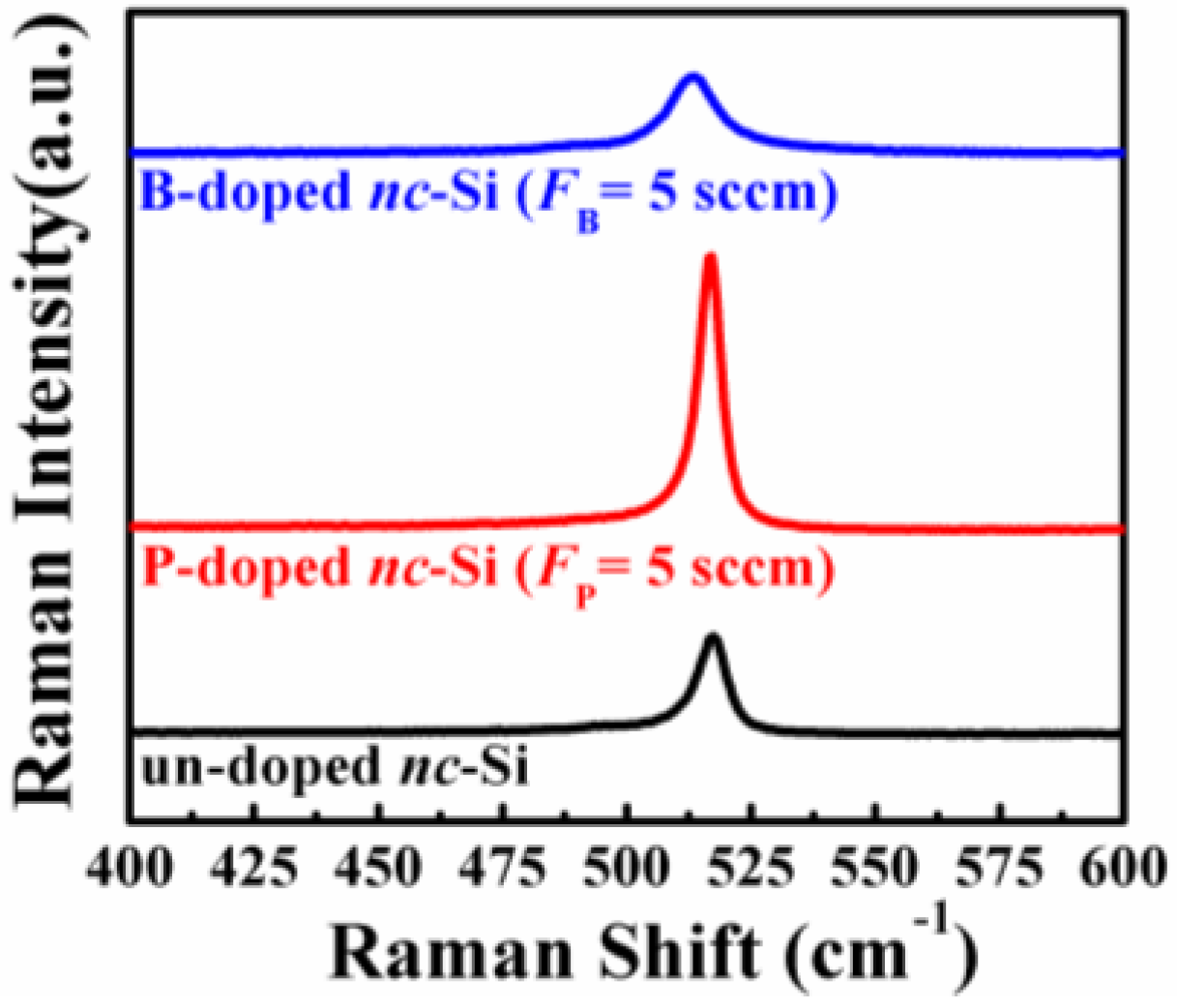
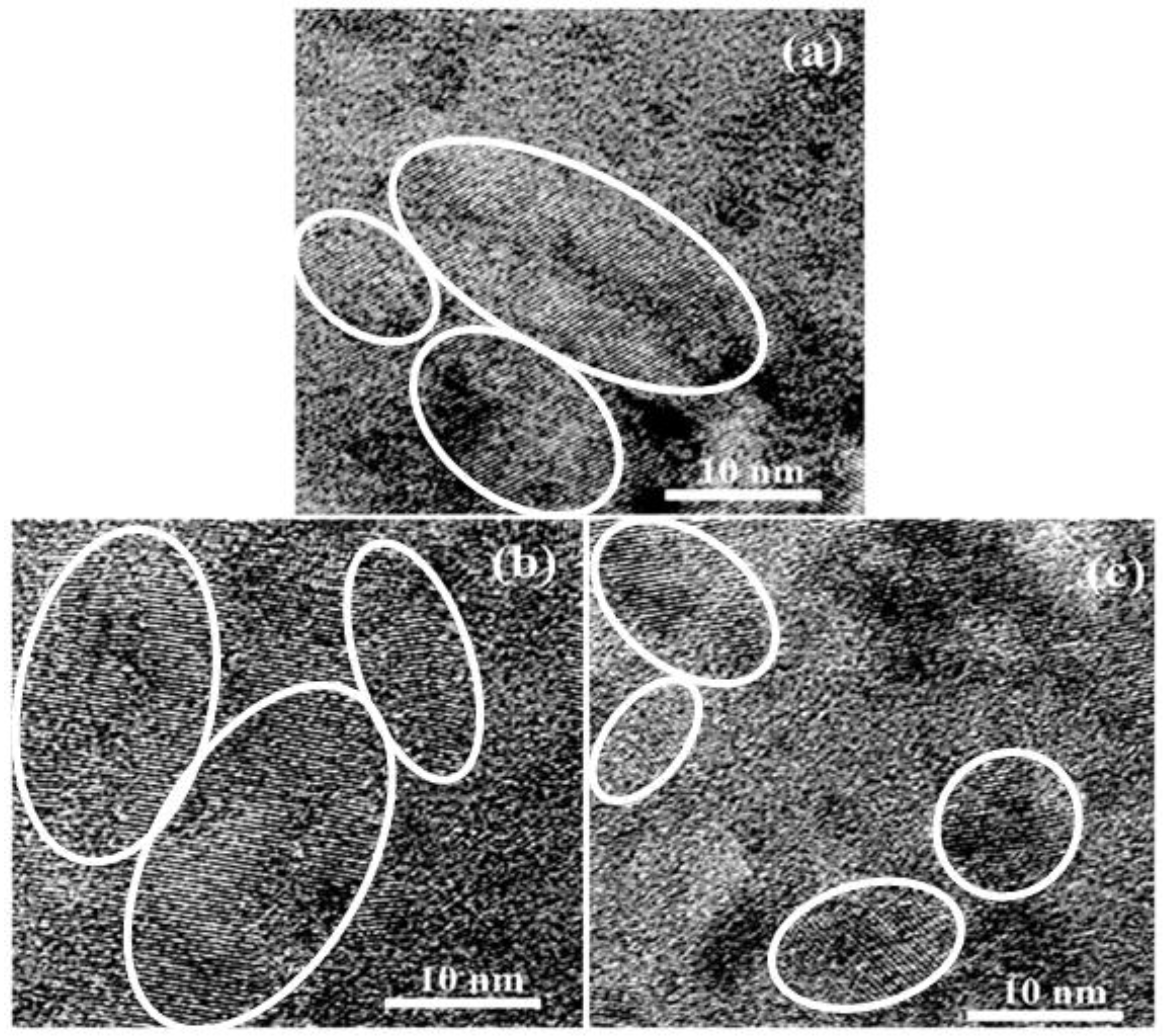
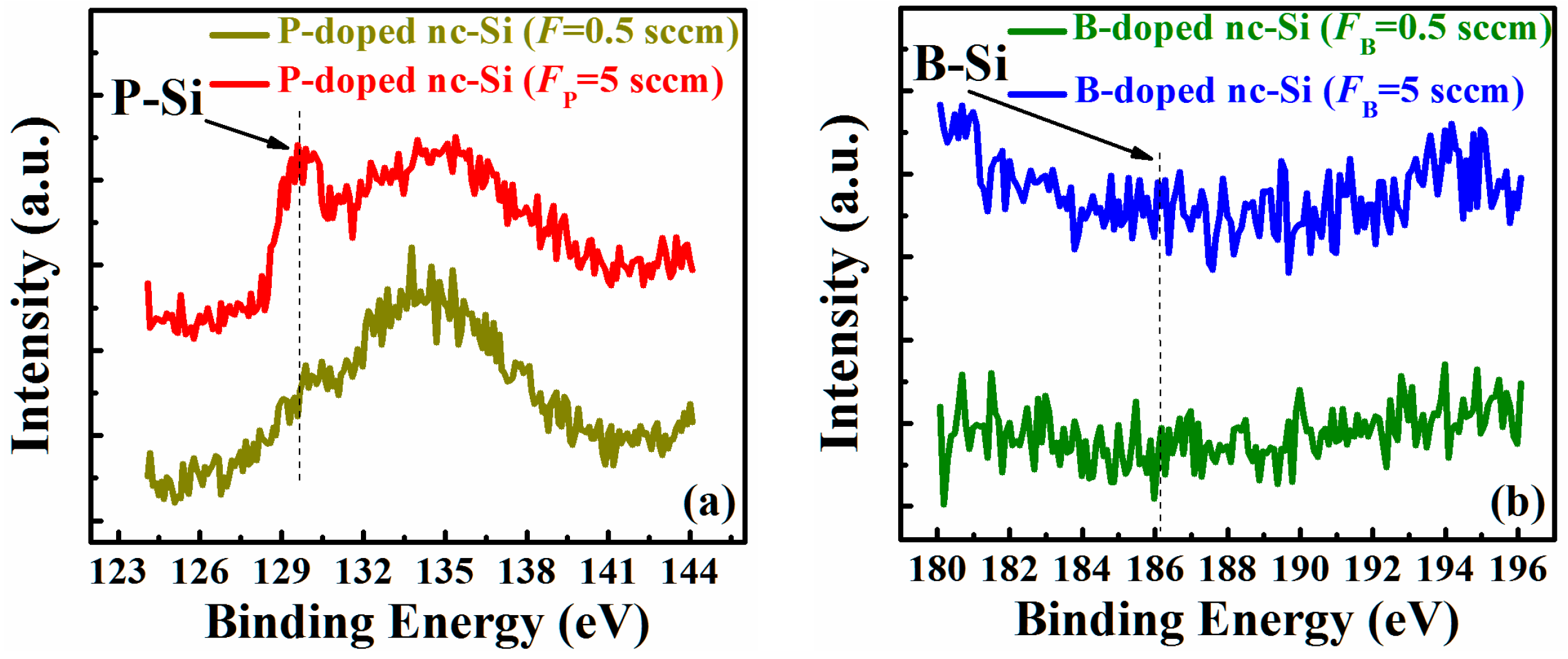
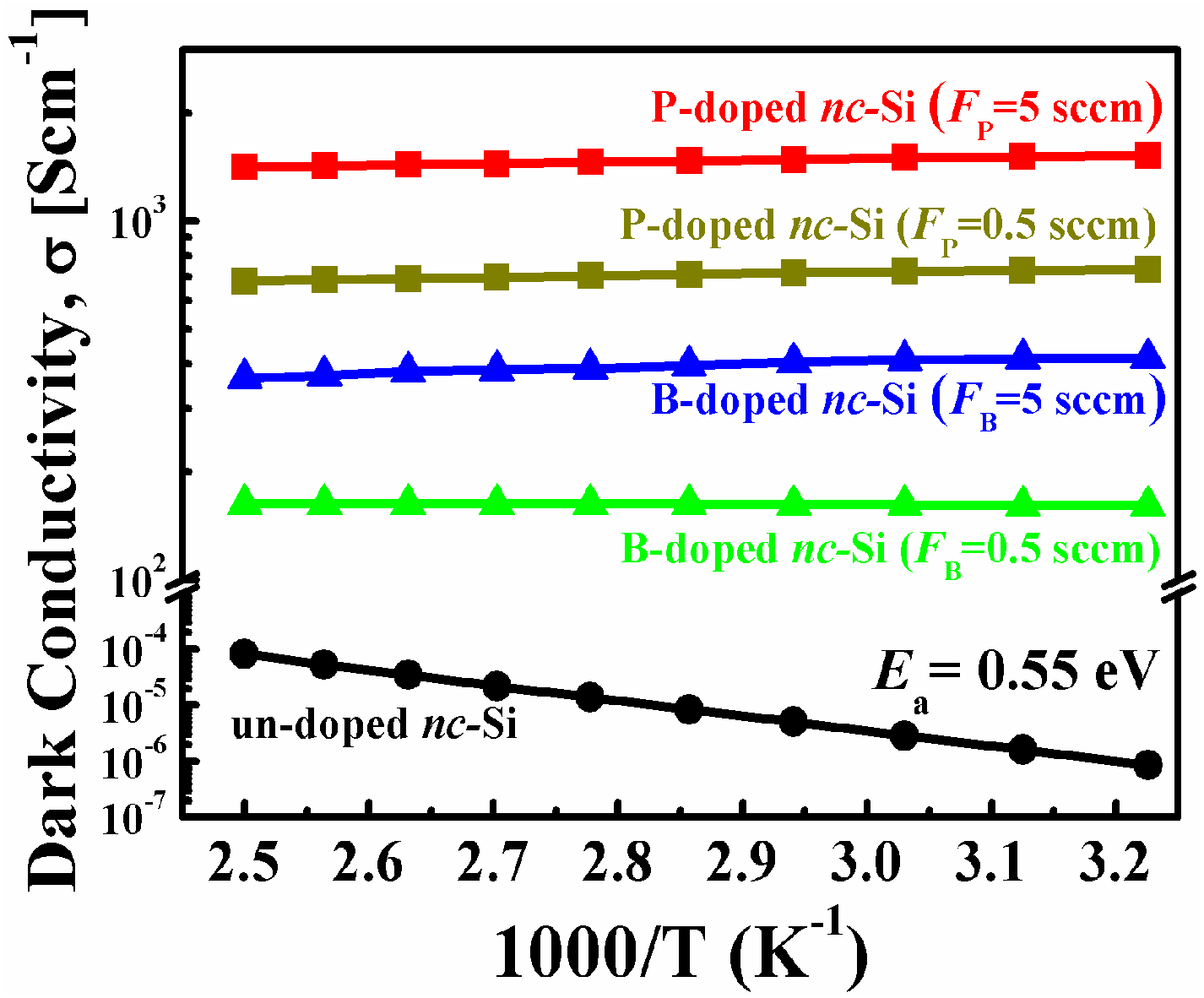
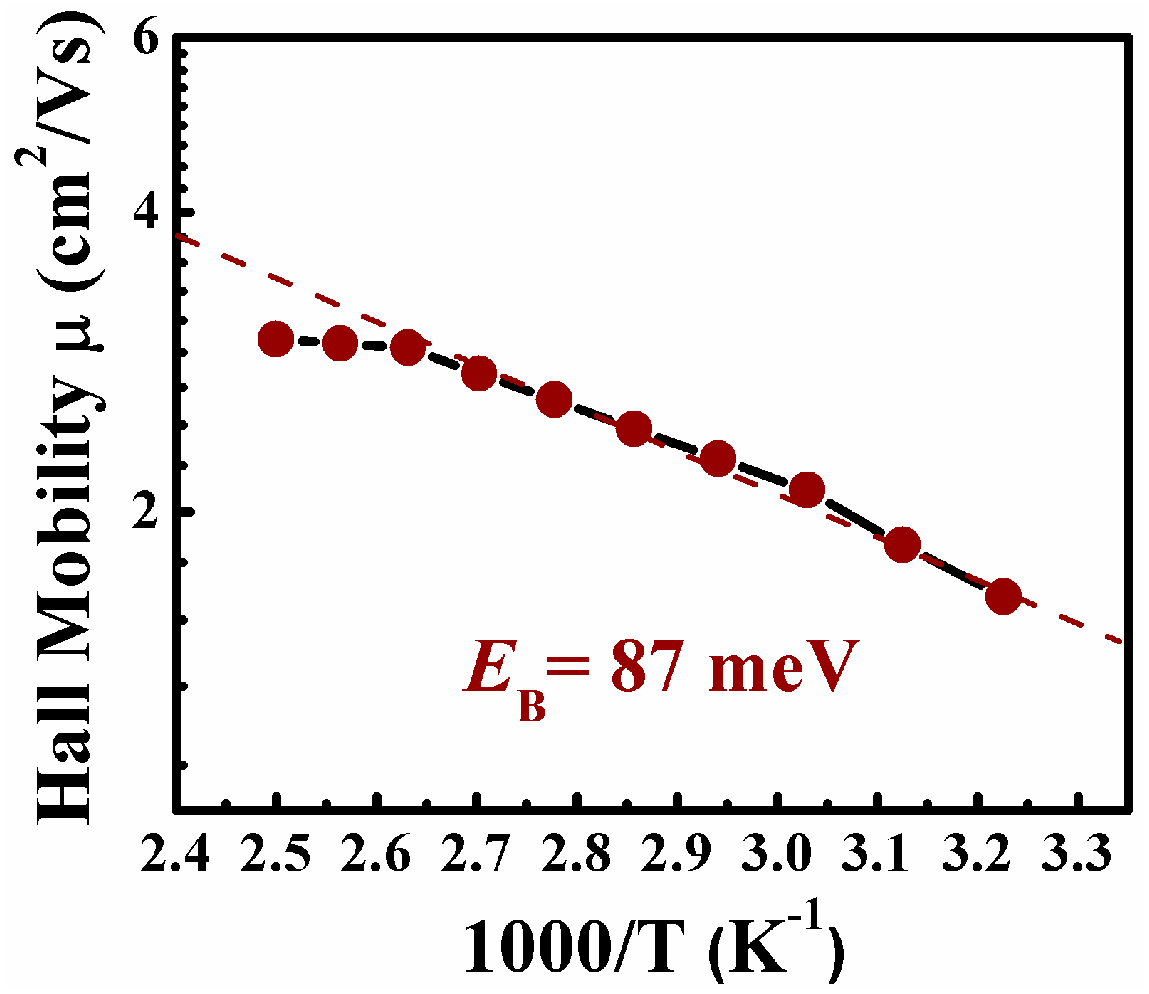

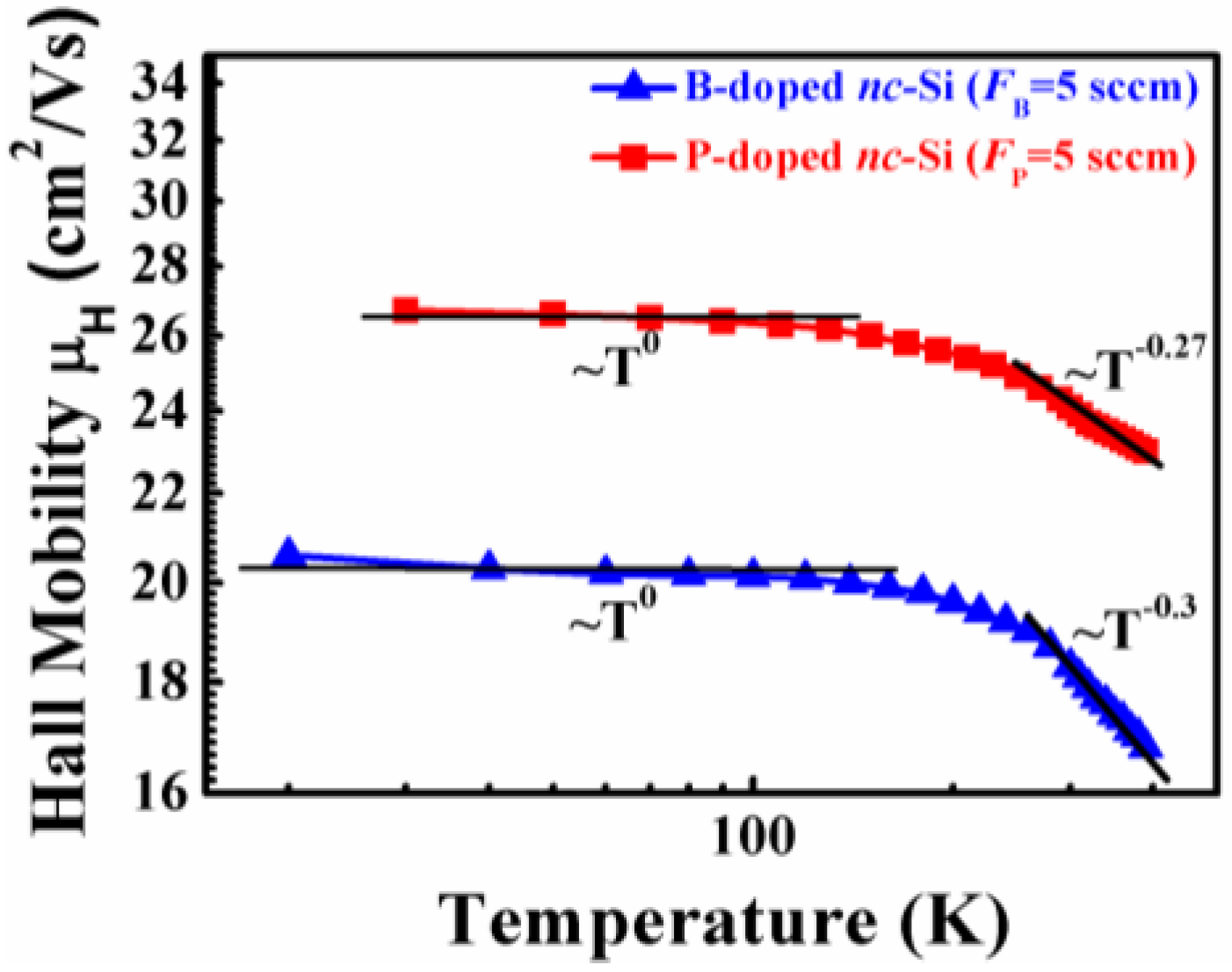
© 2016 by the authors; licensee MDPI, Basel, Switzerland. This article is an open access article distributed under the terms and conditions of the Creative Commons Attribution (CC-BY) license (http://creativecommons.org/licenses/by/4.0/).
Share and Cite
Shan, D.; Qian, M.; Ji, Y.; Jiang, X.; Xu, J.; Chen, K. The Change of Electronic Transport Behaviors by P and B Doping in Nano-Crystalline Silicon Films with Very High Conductivities. Nanomaterials 2016, 6, 233. https://doi.org/10.3390/nano6120233
Shan D, Qian M, Ji Y, Jiang X, Xu J, Chen K. The Change of Electronic Transport Behaviors by P and B Doping in Nano-Crystalline Silicon Films with Very High Conductivities. Nanomaterials. 2016; 6(12):233. https://doi.org/10.3390/nano6120233
Chicago/Turabian StyleShan, Dan, Mingqing Qian, Yang Ji, Xiaofan Jiang, Jun Xu, and Kunji Chen. 2016. "The Change of Electronic Transport Behaviors by P and B Doping in Nano-Crystalline Silicon Films with Very High Conductivities" Nanomaterials 6, no. 12: 233. https://doi.org/10.3390/nano6120233
APA StyleShan, D., Qian, M., Ji, Y., Jiang, X., Xu, J., & Chen, K. (2016). The Change of Electronic Transport Behaviors by P and B Doping in Nano-Crystalline Silicon Films with Very High Conductivities. Nanomaterials, 6(12), 233. https://doi.org/10.3390/nano6120233






